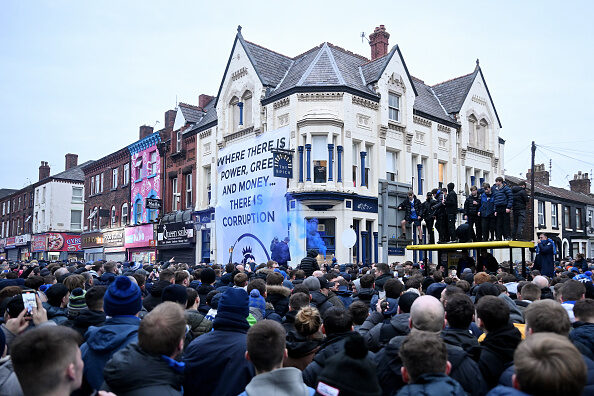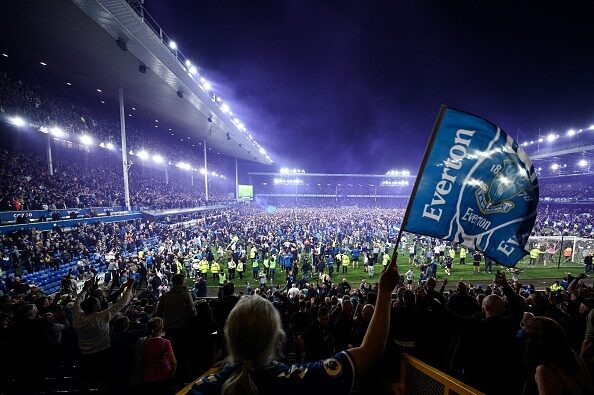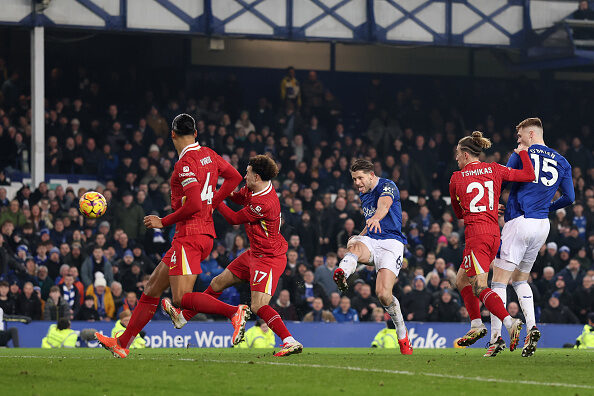Singing the blues. Photo: Oli Scarff/Getty.
It is said that supporting Everton is “the Scousest thing you can do”. That sentiment was always borne out at Goodison Park, the club’s stadium. Queues outside Hot Wok, fireworks and smoke-bombs beside The Brick pub, kids climbing the bus stops on County Road. Not long ago, if you found yourself parking near the stadium, small firms of scallies would insist on “minding your car for a pound” like apprentice Tony Sopranos in Nike Air Max trainers.
Every football fan will tell you that their stadium is a special place. But in an era when the Premier League is dominated by Gulf petrostates, American billionaires and sportswashing autocracies, the 133-year-old Goodison Park stands out. Its old wooden seats and rickety stands, thronging with an aggressive Scouse crowd, distill the mood of a world-gone-by, a throwback, a museum-piece of an old game and an older culture.
The Grand Old Lady juts suddenly upwards from a sea of low-rise, red-brick Victorian terraces. The match-day turnstiles adjoin narrow residential streets, drawing fans into blue-tinged, cramped urban corridors and tunnel-like choke points around strip-lit bars where passing pedestrians jostle with smokers drinking out of plastic cups and Elton John covers belt out of the speakers. Goodison has the highest proportion of season ticket holders as match-day attendees in the league, meaning the crowds are still made up mainly of locals who go to every home game, often down several, usually patrilineal, generations.

The walk to a home game induces a feeling of old-time coziness, like entering a Lowry print — a portal to a different age which doesn’t end inside the ground. We Toffees still welcome a “Toffee Girl” in milkmaid fancy dress to throw sweets into the crowd on match-days as part of an old club tradition. Navigating most of the four stands involves narrow caverns, with fans crammed like sardines towards laughably outdated bars with only a small hope of being served a warm lager or a Bovril before the second half.
But no more. The stands will fall silent for the last time on Sunday after a final match against Southampton — at least until the promised move of Everton’s women’s team gives the ground a renewed feel, and a new, much-welcome but probably more subdued lease of life. Having spent almost a decade under the disastrous stewardship of an Iranian oil magnate, who many said to have been the pawn of a sanctioned Russian oligarch, the club will move to a brand new stadium on the Liverpool waterfront under new ownership in time for the 2025-26 season.
For a while, Everton FC has been as integrated into the globalised, contemporary cash nexus as any other top-flight club, just without being particularly good at operating this new, transnational business model to its advantage. Rather than building patiently upwards with sensible signings of unknown talent from far afield, the boardroom cowboys attempted to short-circuit the game via botched investments in overpriced and ageing players, not to mention a superstar manager tasked with leapfrogging us to success. All the while, the structures of the club were corrosively undermined as the owner involved himself in transfer business over the heads of coaches and directors of football. But now, we have just been bought by a film mogul. Dan Friedkin, the new owner, was also Tom Hardy’s Dunkirk stunt pilot, and so will be familiar with our habit of spinning certain inglorious episodes as evidence of the superior spirit of plucky warriors turning things around against the odds.
Any yet, despite the club’s obvious assimilation into all the sullied, pecuniary culture of today’s footballing elite, Everton somehow manages to exude the aura of a scrappy David against cooler, modern Goliaths. We have nine historic first division titles to our name, more than “Big Six” global mega-brands Chelsea and Tottenham put together. But it’s been a while since Everton won any silverware — an FA Cup three decades ago, and no first division title since 1987.

The biggest eruption of Evertonian roars I can remember have been for last-minute winners, the occasional derby victory, or riotous scenes in the midst of ugly relegation dog-fights. Not, alas, for lifting trophies. But any lower-league supporter will be able to attest that these moments of joy are felt just as viscerally, just as intensely, as the lifting of a silver cup at the apex of the football pyramid.
When my dad watched Everton as a young man, he saw plenty of that. We were even known as the “School of Science”, for our progressive, cutting-edge style of play. It was the Guardiola-ball of its time. With honourable, short-lived exceptions, for most of my life a more recent moniker has seemed more apt: the Dogs of War. What we lack in finesse, artistry and star power has been amply compensated for in effort expended and dogged determination. Some likened the approach of our last manager to “Brexit-ball”, meaning defensive, stubborn, not pretty, with lots of long balls reminiscent of the traditional English game.
It’s no accident that two of the biggest “club legends” of recent years, the embodiments of the Everton spirit, have been Séamus Coleman — a long-serving, passionate Irishman bought from Sligo Rovers for the wild sum of £60,000; and Duncan Ferguson — the only man to have been jailed for a foul committed on a football pitch, who famously “filled in” two burglars who had broken into his house in the heyday of his playing career.
A lot of the Evertonian self-image built up over 30 years of hurt is down to the relative success of a strange group of upstarts based just a mile from Goodison, in the same postcode in fact. Readers may have heard of them — Liverpool FC (the junior team in the city by 14 years compared with us, original founders of the football league). And they have just been crowned champions. No matter: their victory will provide much-needed tourist income for a cash-strapped local economy on Merseyside. It’s a matter of real-life poetic justice that our final local derby in Goodison ended as a 2-2 draw after a 98th-minute equaliser from Everton’s big, six-foot, northern English defender who joined the club on a free transfer, prompting scenes of insane, blue bacchanalia.

But the rivalry between the two clubs almost reflects the Janus face of the city itself: Liverpool — brash, swaggering, sharp, bolshie; and Everton — the perennial underdogs, down-on-their-luck, forever gritty, embittered, aggrieved, and ready to argue, with a chip on both shoulders. If Liverpool’s Anfield draws in visitors from across the world for a glimpse of some melodic chanting and Scouse braggadocio, then Goodison is more associated with the atmosphere of a bear pit, full to the brim with naked aggression interspersed with moments of glorious, reckless, chaotic abandon.
For the three previous seasons we have flirted haphazardly with dropping to the second tier, circling the plughole, like the turd that won’t flush. No other team has spent as long in the top flight as Everton. Leaving it would destroy us, a final nail in the coffin; a last, humiliating deflation after years watching the slow, painful decline of a former giant turned garden gnome.
It’s been a harrowing, sorry saga that has removed cumulative millennia off the life expectancy of tens of thousands of Evertonians through nervous exhaustion. Now, as we await a new stadium, many hope we are turning a corner. But our move begs the question: who are we without Goodison Park? Goodison is Everton. Everton is Goodison. How will we adapt to life apart when so much of our own collective Everton ego is wrapped up in the walls of a big blue behemoth among some of the most deprived streets in northern England?
If Goodison Park represents a time capsule, a monument to the old version of the working-man’s game and proletarian nostalgia, the new stadia have adopted built environments that reflect the spirit of the modern sport: more open, more anonymous, more accessible, inclusive, infinitely better but infinitely worse, an almost computer-generated aesthetic with a big gift-shop ready; day-trippers first, “legacy fans” second. What does it profit a fan if he gains a trophy, but sells his soul? Maybe, just maybe, we’ll find out.
But make no mistake, for all the incongruity of a place like Goodison in the modern age, something priceless, something important, something rooted in the relationship between people, history and place, is now lost forever.









Join the discussion
Join like minded readers that support our journalism by becoming a paid subscriber
To join the discussion in the comments, become a paid subscriber.
Join like minded readers that support our journalism, read unlimited articles and enjoy other subscriber-only benefits.
Subscribe